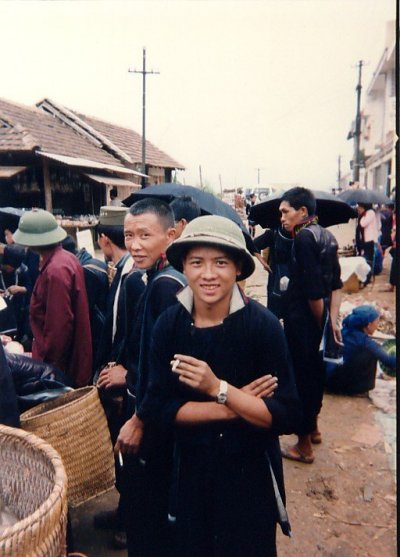Travels in Southeast Asia 1995
Journal Entries by Marc Levy
We are in the tourist market which is in the main part of town. Sapa is on the cusp of China. Outside the village you can see the foundations of blown up buildings, the remains of brick walls silhouetted against a perfect sky. In 1991 the Chinese invaded. They do that every so often. Been at it a thousand years.

The helmets, like the one the guy in the picture is wearing always made me nervous. Worst was when I landed in Hanoi, hitched a ride to town, found a room, unpacked, went out for a walk. It’s a beautiful day. I’m standing under a shade tree by an old church on a main thoroughfare. Bicycles outnumber cars; there is the sound of thin rubber treads gliding over the black asphalt road, the tinny jingle of bicycle bells, the ambient lilt of the language.
It was the pedestrians that got me first. Old men, young men wearing green shirts and pith helmets, and sandals, black sandals (or were they Ho Chi Minh slicks? I do not recall). Some squatted low, in the traditional way, others walked by, and others stood and stared at the sweating tourist. I had not felt such rage and been so addled with panic in a very long time.
It’s hot and humid and the church bell suddenly explodes and makes me crazy. I stagger back to my beautiful white plaster room at the Spring Hotel and tunnel my way to sleep.
Much later in Hue while riding a Chinese bike (see elsewhere re loose handle bars, brakes gone, tires kaput, fenders falling off, the scrawny seat jack knifing up my ass), I saw a lost looking American who might have been a Marine. He had the ten thousand yard stare, and my heart went sad. He was searching for ghosts on a landscape that no longer exists. Hue has been thoroughly cleaned, tidied and spruced up, it’s a holiday town for tourists and Vietnamese. I forced myself to not stop for the ghost man and kept riding. I passed a small park where American tanks, Armored Personnel Carriers, and leviathan cannons were bunched up on a cement square. I hopped off the bike and walked into the frozen ambush; ran my fingers over the cold steel barrels and thick armor plating. I read the graffiti inside the tracks; waited for the howitzers to open fire; any second American troops would come charging out.
Earlier, at the Hanoi Air Force museum I'd had a similar experience only worse since they had more stuff outside and tons within: a jet fighter canopy with the name PARKER stenciled in black paint; olive drab ejection seats, upright, vacant, as if someone had escaped; intact flight helmets sitting like impatient skulls; rows of long silk parachutes splayed across the floor like stranded octopi. Leaving Seth, I walked to a deserted part of the building and spotted an abandoned stack of M-16s. I picked one out of the pile, sat down and immediately went back in time. How long before Seth found me I do not know. He waited as I jabbered non stop about the weapon: push this button and it cracks in half; push this one to release the ammo clip; pull the retractor rod to lock and load; stick a tooth brush under the grill to clean the breach though it will melt during a fire fight; here, after you lift the latch check out the cleaning kit and LSA inside the stock. Very gently Seth called my name. “Put the gun down,” he said, “You should put the gun down.” And childlike I did.